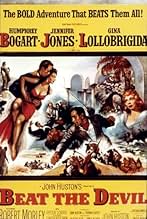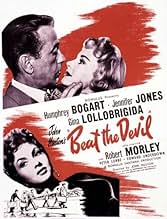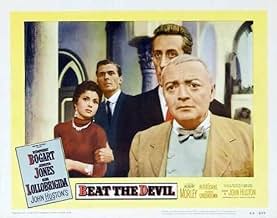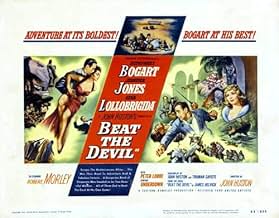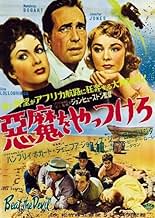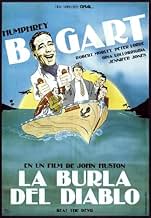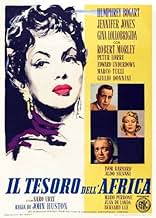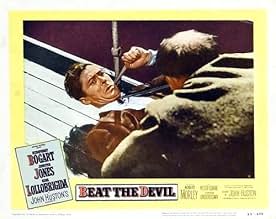IMDb रेटिंग
6.4/10
11 हज़ार
आपकी रेटिंग
आवारा लोगों का एक समूह अमीर होने की उम्मीद से और एक मासूम प्रतीत होता ब्रिटिश युगल अफ्रीका जा रहे हैं. वे मिलते हैं और हादसे होते हैं...आवारा लोगों का एक समूह अमीर होने की उम्मीद से और एक मासूम प्रतीत होता ब्रिटिश युगल अफ्रीका जा रहे हैं. वे मिलते हैं और हादसे होते हैं...आवारा लोगों का एक समूह अमीर होने की उम्मीद से और एक मासूम प्रतीत होता ब्रिटिश युगल अफ्रीका जा रहे हैं. वे मिलते हैं और हादसे होते हैं...
- पुरस्कार
- कुल 1 जीत
Saro Urzì
- Captain of SS Nyanga
- (as Saro Urzi)
Alex Pochet
- Hotel Manager
- (बिना क्रेडिट के)
Mimmo Poli
- Barman
- (बिना क्रेडिट के)
फ़ीचर्ड समीक्षाएं
The above is a line from "Black Widow" that I've always liked. I guess it was called to mind because "Beat the Devil" is a black comedy. Well, it's an odd comedy anyway.
The 1953 film had absolutely everything going for it, including Humphrey Bogart, Jennifer Jones, Gina Lollabrigida, Peter Lorre, Robert Morley, directed by John Huston with a screenplay by Truman Capote. What more could you ask for? I don't know, but something.
The story concerns crooks stuck in Italy while they wait for a steamer to be repaired that is to take them to Africa. There, they will buy land that has uranium on it, though no one knows that. They're allegedly selling vacuum cleaners. Also traveling on this steamer are a British woman (Jones) and her husband. He supposedly is landed gentry in England, but is he? The crooks wonder what he's up to, and the wife keeps changing her story.
There is a lot of humor to be had in this film - the situation is funny, the denouement is wonderful, there is some witty dialogue and there are clever situations that go on during the film that are amusing. The problem is that nobody cares.
The film, which looks like it cost about a dollar to make, is too disjointed, and there are long sections where nothing interesting happens.
One of the posters, who really liked the film, commented that people don't like it because the actors aren't going for laughs. Well, I'm not one of those people. Acting 101 says you don't go for laughs - you play the situation and the characters for real and the laughs happen. That doesn't mean, however, that you pace it like it's Long Days Journey. Bogart had wonderful timing no matter what, and it's evident here, particularly in the car scene on the way to the restaurant, where the character's glibness is apparent. The problem isn't in any person, it's in the direction. I don't believe Huston had a sense of comedy. He could be brilliant, but this was not his thing.
Still, "Beat the Devil" is worth seeing, but it's hard to keep your attention on it.
The 1953 film had absolutely everything going for it, including Humphrey Bogart, Jennifer Jones, Gina Lollabrigida, Peter Lorre, Robert Morley, directed by John Huston with a screenplay by Truman Capote. What more could you ask for? I don't know, but something.
The story concerns crooks stuck in Italy while they wait for a steamer to be repaired that is to take them to Africa. There, they will buy land that has uranium on it, though no one knows that. They're allegedly selling vacuum cleaners. Also traveling on this steamer are a British woman (Jones) and her husband. He supposedly is landed gentry in England, but is he? The crooks wonder what he's up to, and the wife keeps changing her story.
There is a lot of humor to be had in this film - the situation is funny, the denouement is wonderful, there is some witty dialogue and there are clever situations that go on during the film that are amusing. The problem is that nobody cares.
The film, which looks like it cost about a dollar to make, is too disjointed, and there are long sections where nothing interesting happens.
One of the posters, who really liked the film, commented that people don't like it because the actors aren't going for laughs. Well, I'm not one of those people. Acting 101 says you don't go for laughs - you play the situation and the characters for real and the laughs happen. That doesn't mean, however, that you pace it like it's Long Days Journey. Bogart had wonderful timing no matter what, and it's evident here, particularly in the car scene on the way to the restaurant, where the character's glibness is apparent. The problem isn't in any person, it's in the direction. I don't believe Huston had a sense of comedy. He could be brilliant, but this was not his thing.
Still, "Beat the Devil" is worth seeing, but it's hard to keep your attention on it.
I've tried, and tried, and tried, and have now given up trying to figure out the appeal "Beat the Devil" has to a certain clique of film fans. There's no denying its surface appeal. Bogie, Huston, Capote, Lorre, Jones, et al, but I'd have to agree with Bogart who called it a "dog." It's not exciting, it's not funny, and it's not appealing to the eye. The shoddy production values (at least for a film with a cast, director, and writer of such high calibre) were apparent to many critics of the time, so the video and DVD releases probably look no worse than the film did in 1953. The fact that the copyright holders (Bogart's company co-produced) let this fall into the public domain may be a clue to what they thought of it.
"Beat The Devil" is one of Bogart's more unusual films. Scripted by none other than Truman Capote and John Huston, it is a very entertaining, offbeat noir satire (quite a description). Upon first viewing a lot of the humor may get lost, but view it a second time, and you can not help but laugh out loud at many of the jokes.
The cast is absolutely top notch. Bogart is perfect as Billy Dannreuther, a man who has a friend that will line him and his associates up with some land in Africa that is rich with uranium. It's always nice to see Bogie prove that he had a great sense of humor, and didn't mind poking fun at himself. Jennifer Jones, who, for some reason, always reminded me of Vivien Leigh (in "Streetcar")in this picture is terrific as Mrs. Chelm. But it is Robert Morley who steals the picture for me. Sometimes menacing, sometimes charming, he is a delight to watch.
Huston and Capote have done a great job of blending the different genres without letting them get all caught up in each other. I do wish that the final scene was written a little better, but the movie is still a lot of fun.
Caution - because the film was allowed to enter the public domain, there are a lot of really lousy prints out on the market, even on DVD. If you want this film for your own collection, do yourself a favor and spend a couple of extra dollars and buy a good print.
7 out of 10
The cast is absolutely top notch. Bogart is perfect as Billy Dannreuther, a man who has a friend that will line him and his associates up with some land in Africa that is rich with uranium. It's always nice to see Bogie prove that he had a great sense of humor, and didn't mind poking fun at himself. Jennifer Jones, who, for some reason, always reminded me of Vivien Leigh (in "Streetcar")in this picture is terrific as Mrs. Chelm. But it is Robert Morley who steals the picture for me. Sometimes menacing, sometimes charming, he is a delight to watch.
Huston and Capote have done a great job of blending the different genres without letting them get all caught up in each other. I do wish that the final scene was written a little better, but the movie is still a lot of fun.
Caution - because the film was allowed to enter the public domain, there are a lot of really lousy prints out on the market, even on DVD. If you want this film for your own collection, do yourself a favor and spend a couple of extra dollars and buy a good print.
7 out of 10
As Hollywood production became ever more individualised, with writers-directors and producer directors working independently of the studios, there were many pictures which attacked Hollywood conventions themselves. In Beat the Devil writer-director John Huston gives us a farcical take upon the recurring heist-gone-wrong subgenre. The style now known as film noir may not have been fully defined and discussed until the 60s, but any keen-minded cinemagoer can recognise a trend. And if a trend can be recognised then it is open to parody.
It looks however as if Beat the Devil may have begun life as a serious thriller. All the business about criminals going after uranium mines in Africa seems fairly original, and is certainly not an archetypal noir plot. And really there is no grand satire here, and no lampooning of specific genre clichés. The story's premise is essentially serious, yet is written with comedy characters and comical mishaps along the way. It's if Huston and his co-writer Truman Capote simply gave up on following it through and instead decided to have a bit of fun with it.
Nevertheless, Huston shoots this one with the same thoughtfulness and precision as he would a drama. As always, he favours set-ups which keep multiple actors in shot together, background and foreground, minimising on cuts between them. With some neat movements he is able to bring the right person to our attention at the right moment, for example the scene in which we first see Humphrey Bogart and Gina Lollobrigida. Bogart paces back and forth in the foreground moving in and out of shot, while Lollobrigida is in mid-shot but sat in the same place, meaning the two of them take turns to be the focal point without lots of editing or obtrusive camera-work. Another neat touch is when the major approaches Bogart at the outdoor table, starting off in the background as if an extra, until it becomes apparent he is worth taking note of. Huston's technique is about elaborate arrangement to keep all characters involved and performances intact without the distractions of film form.
And here there are many characters and performances worth looking at. As befitting for the tone, this is a real outing for oddball supporting players. Peter Lorre is at his very best, all shiftiness and lethargic mannerisms, while Robert Morley gleefully portrays his blustering and conspicuous opposite, and Ivor Barnard hams up his caricature of the puffed-up ex-army fascist. It appears these three fine character actors have been told to simply let go and play their familiar types to the hilt. By contrast, lesser-known Italian Marco Tulli gives a far more restrained performance, but he is in a way the funniest. There's a great moment somewhere in there while the other three are bickering and he is just sat in the middle of the shot, quietly blinking away like some daft meerkat. Even the tiniest roles are filled – often impeccably – by comedy players, many of whom are not well-known in English-language cinema. There's also a great turn by Jennifer Jones, at her most comical and almost unrecognisable as an eccentric Englishwoman, showing superb comic timing as she casually beats her husband at chess. With so much scene-stealing going on, it's possible to forget this is ostensibly a Humphrey Bogart movie.
But while Beat the Devil is full of quirky characters and has numerous funny little moments, it doesn't have much point beside that. The humour is never exactly hilarious because the whole thing really doesn't seem conceived as a comedy. There's not enough of the interaction between crazy characters and sane world which drives wild comedy (such as the Marx Brothers), because in Beat the Devil virtually everyone and everything is crazy. Meanwhile the only completely straight characters (Bogart and Lollobrigida) are simply dull marginalised figures who exist separately from the comedy yet don't have the strength to perk up their end of the movie. Overall it is just a chaotic mess that happens to be worth a chuckle here and there.
It looks however as if Beat the Devil may have begun life as a serious thriller. All the business about criminals going after uranium mines in Africa seems fairly original, and is certainly not an archetypal noir plot. And really there is no grand satire here, and no lampooning of specific genre clichés. The story's premise is essentially serious, yet is written with comedy characters and comical mishaps along the way. It's if Huston and his co-writer Truman Capote simply gave up on following it through and instead decided to have a bit of fun with it.
Nevertheless, Huston shoots this one with the same thoughtfulness and precision as he would a drama. As always, he favours set-ups which keep multiple actors in shot together, background and foreground, minimising on cuts between them. With some neat movements he is able to bring the right person to our attention at the right moment, for example the scene in which we first see Humphrey Bogart and Gina Lollobrigida. Bogart paces back and forth in the foreground moving in and out of shot, while Lollobrigida is in mid-shot but sat in the same place, meaning the two of them take turns to be the focal point without lots of editing or obtrusive camera-work. Another neat touch is when the major approaches Bogart at the outdoor table, starting off in the background as if an extra, until it becomes apparent he is worth taking note of. Huston's technique is about elaborate arrangement to keep all characters involved and performances intact without the distractions of film form.
And here there are many characters and performances worth looking at. As befitting for the tone, this is a real outing for oddball supporting players. Peter Lorre is at his very best, all shiftiness and lethargic mannerisms, while Robert Morley gleefully portrays his blustering and conspicuous opposite, and Ivor Barnard hams up his caricature of the puffed-up ex-army fascist. It appears these three fine character actors have been told to simply let go and play their familiar types to the hilt. By contrast, lesser-known Italian Marco Tulli gives a far more restrained performance, but he is in a way the funniest. There's a great moment somewhere in there while the other three are bickering and he is just sat in the middle of the shot, quietly blinking away like some daft meerkat. Even the tiniest roles are filled – often impeccably – by comedy players, many of whom are not well-known in English-language cinema. There's also a great turn by Jennifer Jones, at her most comical and almost unrecognisable as an eccentric Englishwoman, showing superb comic timing as she casually beats her husband at chess. With so much scene-stealing going on, it's possible to forget this is ostensibly a Humphrey Bogart movie.
But while Beat the Devil is full of quirky characters and has numerous funny little moments, it doesn't have much point beside that. The humour is never exactly hilarious because the whole thing really doesn't seem conceived as a comedy. There's not enough of the interaction between crazy characters and sane world which drives wild comedy (such as the Marx Brothers), because in Beat the Devil virtually everyone and everything is crazy. Meanwhile the only completely straight characters (Bogart and Lollobrigida) are simply dull marginalised figures who exist separately from the comedy yet don't have the strength to perk up their end of the movie. Overall it is just a chaotic mess that happens to be worth a chuckle here and there.
Humphrey Bogart heads a superior cast in this tale of a gang of swindlers who seek to covertly purchase African lands rich in uranium--but this is not the tough film noir you might expect: the script by director John Huston and Truman Capote upends the tale to create one of the most wry and wicked comedies going, and a remarkably fine cast follows suit with a host of eccentric performances.
Although Bogart does not look his best (this film was made toward the end of his life), he offers an understated yet very witty performance as Billy Dannreuther, the man the crooks hire to make the land purchase. His leading ladies, bombshell Gina Lollobrigida and an unexpectedly blonde Jennifer Jones, are equally effective in the roles of Bogart's cheerfully pragmatic wife and the pathological liar with whom Bogart becomes romantically entangled. But the big news in this film is the supporting cast. Robert Morley, Peter Lorre, Ivor Barnard, and Marco Tulli give drop-dead-funny performances as the largely incompetent foursome behind the landsnatch scheme; Edward Underdown (as Jones' long suffering husband) is simply the most completely ludicrous Brit to hit the screen since 1930s screwball comedy; and all the cameo players nail their roles to perfection.
It would be unforgivable to give away too much of the story, but suffice to say that one wrong turn leads to another. The film never overplays its hand, maintaining a low key tone that sets off the wickedly funny script to delightful effect. Some viewers may not get the joke--much of BEAT THE DEVIL requires the ability to appreciate covert humor--but those who do will find the movie bears repeat viewing. Recommended.
Gary F. Taylor, aka GFT, Amazon Reviewer
Although Bogart does not look his best (this film was made toward the end of his life), he offers an understated yet very witty performance as Billy Dannreuther, the man the crooks hire to make the land purchase. His leading ladies, bombshell Gina Lollobrigida and an unexpectedly blonde Jennifer Jones, are equally effective in the roles of Bogart's cheerfully pragmatic wife and the pathological liar with whom Bogart becomes romantically entangled. But the big news in this film is the supporting cast. Robert Morley, Peter Lorre, Ivor Barnard, and Marco Tulli give drop-dead-funny performances as the largely incompetent foursome behind the landsnatch scheme; Edward Underdown (as Jones' long suffering husband) is simply the most completely ludicrous Brit to hit the screen since 1930s screwball comedy; and all the cameo players nail their roles to perfection.
It would be unforgivable to give away too much of the story, but suffice to say that one wrong turn leads to another. The film never overplays its hand, maintaining a low key tone that sets off the wickedly funny script to delightful effect. Some viewers may not get the joke--much of BEAT THE DEVIL requires the ability to appreciate covert humor--but those who do will find the movie bears repeat viewing. Recommended.
Gary F. Taylor, aka GFT, Amazon Reviewer
क्या आपको पता है
- ट्रिवियाHumphrey Bogart was involved in a serious automobile accident during production of this film, which knocked out several of his teeth and hindered his ability to speak. John Huston reportedly hired a young British actor noted for his mimicry skills to rerecord some of Bogart's spoken lines during post-production looping. Although it is undetectable when viewing the film today, it is Peter Sellers who provides Bogart's voice during some of the scenes in this movie. However this cannot be confirmed.
- गूफ़Bogie enters the lifeboat wearing a plain suit but gets out wearing a pinstriped suit.
- भाव
Julius O'Hara: Time. Time. What is time? Swiss manufacture it. French hoard it. Italians squander it. Americans say it is money. Hindus say it does not exist. Do you know what I say? I say time is a crook.
- इसके अलावा अन्य वर्जनThe original American release version was truncated and had scenes moved around, making a mess of the story line. The uncut version--released overseas by Romulus--was finally restored in the U.S. by Sony in 2016.
- कनेक्शनEdited into Your Afternoon Movie: Beat the Devil (2022)
टॉप पसंद
रेटिंग देने के लिए साइन-इन करें और वैयक्तिकृत सुझावों के लिए वॉचलिस्ट करें
- How long is Beat the Devil?Alexa द्वारा संचालित
विवरण
बॉक्स ऑफ़िस
- बजट
- $10,00,000(अनुमानित)
- चलने की अवधि1 घंटा 29 मिनट
- रंग
- पक्ष अनुपात
- 1.37 : 1
इस पेज में योगदान दें
किसी बदलाव का सुझाव दें या अनुपलब्ध कॉन्टेंट जोड़ें


